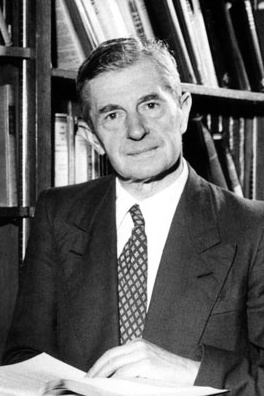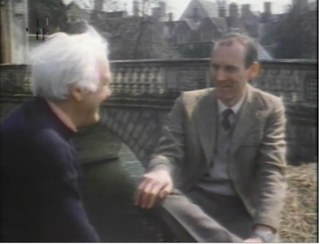Related Research Articles

The Royal Astronomical Society (RAS) is a learned society and charity that encourages and promotes the study of astronomy, solar-system science, geophysics and closely related branches of science. Its headquarters are in Burlington House, on Piccadilly in London. The society has over 4,000 members, known as fellows, most of whom are professional researchers or postgraduate students. Around a quarter of Fellows live outside the UK.

William Maurice "Doc" Ewing was an American geophysicist and oceanographer.

Sydney Chapman was a British mathematician and geophysicist. His work on the kinetic theory of gases, solar-terrestrial physics, and the Earth's ozone layer has inspired a broad range of research over many decades.
Sir Kingsley Charles Dunham was one of the leading British geologists and mineralogists of the 20th century. He was a Professor of Geology at the University of Durham from 1950–71. He was later Professor Emeritus from 1967–2001. He was director of the British Geological Survey from 1967–75.

Ernest Ronald Oxburgh, Baron Oxburgh, is an English geologist, geophysicist and politician. Lord Oxburgh is well known for his work as a public advocate in both academia and the business world in addressing the need to reduce carbon dioxide emissions and develop alternative energy sources as well as his negative views on the consequences of current oil consumption.

Frederick John Vine FRS is an English marine geologist and geophysicist. He made key contributions to the theory of plate tectonics, helping to show that the seafloor spreads from mid-ocean ridges with a symmetrical pattern of magnetic reversals in the basalt rocks on either side.
Keith Edward Bullen FAA FRS was a New Zealand-born mathematician and geophysicist. He is noted for his seismological interpretation of the deep structure of the Earth's mantle and core. He was Professor of Applied Mathematics at the University of Sydney in Australia from 1945 until 1971.
Sir Edward Crisp Bullard FRS was a British geophysicist who is considered, along with Maurice Ewing, to have founded the discipline of marine geophysics. He developed the theory of the geodynamo, pioneered the use of seismology to study the sea floor, measured geothermal heat flow through the ocean crust, and found new evidence for the theory of continental drift.
Herbert Eric Huppert is a British geophysicist. He has been Professor of Theoretical Geophysics and Foundation Director, Institute of Theoretical Geophysics, at the University of Cambridge, since 1989 and Fellow of King's College, Cambridge, since 1970.
Ronald M. Clowes, CM is a professor specializing in seismic and other geophysical studies of the Earth's lithosphere. For his work he has been appointed a member of the Order of Canada.
Andrew Christopher Fabian is a British astronomer and astrophysicist. He was Director of the Institute of Astronomy, University of Cambridge from 2013 to 2018. He was a Royal Society Research Professor at the Institute of Astronomy, Cambridge from 1982 to 2013, and Vice-Master of Darwin College, Cambridge from 1997 to 2012. He served as president of the Royal Astronomical Society from May 2008 through to 2010.

Professor Kurt Lambeck AC, FRS, FAA, FRSN is Professor of Geophysics at the Australian National University in Canberra, Australia. He has also taught at University of Paris and at Smithsonian and Harvard Observatories.
(Stanley) Keith Runcorn was a British physicist whose paleomagnetic reconstruction of the relative motions of Europe and America revived the theory of continental drift and was a major contribution to plate tectonics.
Sir Alan Hugh Cook FRS was an English physicist who specialised in geophysics, astrophysics and particularly precision measurement.

Steven Andrew Balbus is an American-born astrophysicist who is the Savilian Professor of Astronomy at the University of Oxford and a professorial fellow at New College, Oxford. In 2013, he shared the Shaw Prize for Astronomy with John F. Hawley.

Anthony Brian Watts FRS is a British marine geologist and geophysicist and Professor of Marine Geology and Geophysics in the Department of Earth Sciences, at the University of Oxford.
John Conrad Jaeger, FRS was an Australian mathematical physicist.
David Gubbins is a British former geophysicist concerned with the mechanism of the Earth's magnetic field and theoretical geophysics. He is Emeritus Professor of Earth Sciences at Leeds University.
John Henry Woodhouse is an English geophysicist, Emeritus Professor in the Department of Earth Sciences at the University of Oxford.
John-Michael Kendall is a Geophysicist and Professor in the Department of Earth Sciences at the University of Oxford.
References
- 1 2 3 4 5 6 "England, Prof. Philip Christopher, (born 30 April 1951), Professor of Geology, Oxford University, 2000–19". Who's Who 2021. Oxford University Press. 1 December 2020. Retrieved 7 March 2021.
- 1 2 3 4 5 "Philip England". Royal Society. Retrieved 7 March 2021.
- ↑ "The Geological Society of London - 2004 Awards: Citations, Replies". www.geolsoc.org.uk.
- ↑ "RAS honours leading astronomers and geophysicist". RAS. 8 January 2015. Archived from the original on 20 July 2016. Retrieved 9 January 2015.